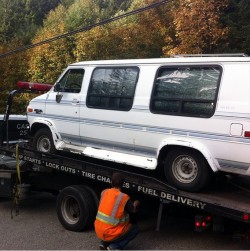What do you do when you achieve one of your biggest dreams…and it kind of sucks?
Actually, scratch that. It really sucks.
I write goal lists. By candle light, with incense burning or as I blow out the candles on each birthday, I relish another opportunity to put it all down on paper.
For three years there was one goal sitting at the top of my list of goals.
“Become location-independent and live in a van.”
This was my big why for three years, the thing behind all of the things that I do daily to run my business. Each new venture measured against the idea of vanlife, as I asked “does this fit with my goal?” Anything that kept me location-based and heavy I scrapped.
I manifested, tucked crystals in my pockets, made Pinterest boards filled with vans and followed blogs of fellow wanderers. Every day for three years I felt the pull.
The seductive pull that told me “everything is going to be great when…”
Moving to the West Coast USA and living in a van was my personal light at the end of the tunnel. A move that to me symbolized finding a place of groundedness, earthiness, sensuality. A simpler way of life that was more in tune with nature and my own rhythms. A way to live frugally and on my own terms.
Besides, the idea struck me as a way to give the middle finger to everyone who’s ever asked me when I’m going to settle down and get a real job.
I’ll do this on my own terms — live in a van off-the-grid, run a business, stay profitable and become a huge success.
And the thing is, wildly, ridiculously it almost worked.
In September 2014, my partner and I sold what little stuff we had and bought two plane tickets from Philly to Portland. We bought an old van for 800 bucks, tore out the seats and installed fake wood floors, dumped a futon mattress in the back and moved in.
My #1 dream finally came true and it sucked. Hard.
We slept in Walmart parking lots across Washington, Oregon and California, showered at the gyms and ate what we could find out on the road.
I was cold, miserable and more ungrounded then I’ve ever felt before.
One tear-filled night as I was tallying up how much we’d spent, I realized that we could have just spent our time living in a beautiful, comfortable apartment. I felt disappointed with my intention to live close-to-the-earth, when I realized that 90% of our budget went to big box stores, gas stations and fast food joints that we had access to on the road. Sleeping in Walmart parking lots was depressing and I was struggling to keep up with my work and client projects without access to wifi.
We broke down in Mt. Rainer, got stuck in a snowbank on a mountain, washed out in Northern California, drove 45 minutes just to shower in Reno and got pulled over in Washington.

(What life on the road actually looks like.)
So what do you do when you finally achieve that big dream, only to find out that it actually sucks hard?
Looking back of this experience I feel a lot of gratitude, without the residual wash of regret or disappointment. I acknowledge the van experience as a clarity point. A place for me to sit with discomfort and say “surprisingly, this is an example of what I don’t want.” Because from that experience, a new layer of understanding about what I did want and need was born.
Comfort, yes.
Ease, yes.
Showers, yes.
A kitchen to cook my healthy food, yes.
A routine so that I can do my best, most inspired work, yes.
Knowing these simplistic desires is what has made life on the flipside so sweet for me right now. Washing dishes in a sink instead of in a bucket around the back of Walmart is blissful in comparison.
So what is required to gracefully pivot?
First, you need to be brave enough to acknowledge that it isn’t working. This can be f*cking hard, soul-wrenching, gut-wrenching, disappointing, embarrassing and really sorrowful to admit that something that you dreamed about, put up on your vision board and told all of your network has failed so spectacularly.
Danielle LaPorte, author of The Desire Map explains,
“The road to mediocrity is…easy. 80% of people will proceed as planned — they’ll keep their mouth shut, save money, save face, not rock the boat. 20% (and that may be a generous portion), will risk looking like an indecisive, unreasonable, flake and they’ll put on the brakes, push for change, throw a wrench into the works, ask for unreasonable Olympian efforts at the last minute. The people in the latter camp? They tend to be outstanding. Their risks are more likely to pay off — because they take them.”
Next — and this is an important and necessary part of the process — is to let yourself feel what you feel. I cried so hard when I realized that my dream was falling to pieces, we were hemorrhaging our money on the road and this lifestyle just wasn’t sustainable.
Then, and only then, do you sit down like a scientist and dispassionately put your situation under a microscope and analyze. I was inspired by an article on INC.com discussing the topic of pivots in the business landscape.
Specifically this idea:
“Through pivots we can build companies where the failure of the initial idea isn’t the failure of the company. For some entrepreneurs, the toughest part of a pivot may be setting aside their personal convictions — and egos. It’s very hard as an entrepreneur to move away from your core idea, but if your customers are telling you to, you have to learn to be flexible.”
My life is a lean startup and the graceful pivot is responsible for the manifestation of all the wonderful things in my life.
When I reached a critical mass of success in my business this year, it was due to a pivot. Moving from yoga teacher/health writer to website designer was a massive pivot for me and came out of my desire to honestly look at what wasn’t working for me in my business and bravely choose a new path.
From LaPorte, again,
“We get clear about what we really truly actually for real want at pull-the-trigger time by virtue of psyche mechanics — we’ve been grinding and polishing for so long that we’re more likely to see a new vein surface in the material; and because our soul is determined to take it’s true shape in the world (not that we always let it.)”
What’s difficult about a pivot is not the pivot itself — that can feel almost like a huge sigh of relief — but the ego-smash that comes with admitting and acknowledging the need for pivoting. And that’s where grace and flexibility are required.
When you can accept the dynamic waves of life, business, love, you can learn how to become equally fluid. Turning your pivot into a dance, where each step brings you closer to a state of graceful, honest presence.
And how I wound up living in a van in the Pacific Northwest to living in on the tiny Mediterranean island of Malta? Well, that’s another pivot story for another time.
Relephant Read:
7 Things I Learned by Growing Up a Nomad.
Author: Nicole Harlow
Editor: Catherine Monkman
Images: Author’s Own, Jon Atherton/Flickr









Read 0 comments and reply